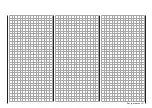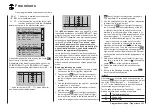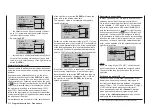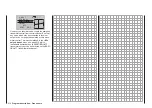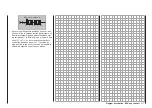
208 Program description - Free mixers
Mixer
Effect
N.N.*
2
servo pair 2 + 5 responds with an
aileron function
N.N.*
5
servo pair 2 + 5 responds with a
flap function
N.N.*
6
servo pair 6 + 7 responds with a
flap function
N.N.*
7
servo pair 6 + 7 responds with an
aileron function
N.N.*
9
servo pair 9 + 10 responds with a
flap function
N.N.*
10
servo pair 9 + 10 responds with an
aileron function
N.N.*
11
servo pair 11 + 12 responds with a
flap function
N.N.*
12
servo pair 11 + 12 responds with
an aileron function
• Model helicopters:
With helicopter mixers, collective pitch control may
be provided by up to 4 servos connected to receiv-
er outputs 1, 2, 3 and 5, depending on helicopter
type. The software links these together to control
collective pitch, roll and pitch-axis.
Other than within the »Helicopter mixers« menu,
it is not advisable to mix a free mixer into these
channels because this can lead to very complex
interactions. One of the few exceptions is “Collec-
tive pitch trim using a separate transmitter con-
trol” – see example 3 on page 213.
Important notices:
• With serial links in particular, remember that
the travels of the individual mixers are cumu-
lative if multiple stick commands are made si-
multaneously: there is a risk that the servo(s)
Tip:
If you separate a control function – for example ,“9” – in
the »Mix-only channel« menu, see page 216, then
the servo’s response is determined exclusively by the
mixer input of a mixer programmed from “9
9”. This
menu is available as standard on the
mc-20
HoTT
transmitter only, but can be unlocked as an extra-cost
option on the
mc-16
HoTT. Thus, with linear mix-
ers M1 … 8 or curve mixers C9 … 12, 6-point control
curves can be defined for any transmitter control in a
manner analogous to that described in the »Channel
1 curve« menu and these can also be used in flight
phase switching if needed. This method of “linking” is
not only also switchable but can even be subject to a
delay by assigning an appropriate delay in the “– time
+” column of the »Control adjust« menu.
Mixer output affecting default software coupling
of aileron, camber-changing flap or collective
pitch servos
Before we start specifying the mixer ratio, we must
first give some thought to what happens if we permit
a mixer to affect the default software coupling of ai-
leron, camber-changing flap or collective pitch servos:
• Fixed-wing models:
Depending on the number of wing servos available
on the “Aile/flaps” line of the »Model type« menu,
control channels 2 and 5 are connected via spe-
cial mixers for the “aileron” function, 6 and 7 for the
“flap” function, outputs 9 and 10 (if present) for the
FLAP2 servos and 11 and 12 for AILE2 servos.
If mixer outputs are programmed to affect these
kinds of couplings, then their effect on the respec-
tive flap pair derived from the “receiving” control
channel must be accounted for:
may strike a mechanical end-stop. If neces-
sary, reduce “servo travel” to avoid this; alter-
natively, set “Travel limit” on the “Servo adjust-
ment” menu and/or reduce mixer values.
• Take advantage of the ever-present option to
switch over to the transmitter’s »Servo dis-
play« menu, see page 274. This menu is
reached from almost any menu with a brief, si-
multaneous tap on the
keys of the left
four-way button. This menu gives you the op-
portunity to check the effects of all of your set-
tings on a single screen.
Mixer ratios and mixer neutral point
Now that we have explained the wide-ranging nature
of the mixer functions, the following section describes
how to program linear and non-linear mixer curves.
For each of the 12 available mixers, the mixer curves
are programmed on a second page of the screen
display. Use the selection keys
on the left or right
four-way button to select the desired mixer line. If
necessary, use the four-way button’s selection keys
to move to the right column (“
”) then briefly tap the
center
SET
key of the right four-way button to access
the graph page.
M1 … 8: Setting linear mixer values
As a practical example, we will now define a linear
mixer curve to resolve the following problem:
For a motorized aircraft model, the two servos con-
nected to receiver outputs 6 and 7 – defined on
the “Aile/flaps” line of the »Model type« menu as
“… 2FL” – are to be used for actuating landing flaps.
That is; when a transmitter control is moved, they
must deflect downwards only. This requires a simulta-
neous elevator trim, however.
First allocate, for example, input 6 to the left slider
control Sl1 located in the middle of the console by
making settings in the »Control adjust« menu.
A transmitter control on input 6, – as shown in the
* N.N. = Nomen Nominandum (der zu nennende Name)
Содержание HoTT MC-16 Series
Страница 1: ...Programming Manual mc 16 mc 20 HoTT 1 en mc 16 mc 20...
Страница 27: ...27 For your notes...
Страница 53: ...53 For your notes...
Страница 61: ...61 For your notes...
Страница 65: ...65 For your notes...
Страница 71: ...71 For your notes...
Страница 103: ...103 For your notes...
Страница 107: ...107 For your notes...
Страница 111: ...111 For your notes...
Страница 133: ...133 Program description Dual Rate Expo Winged models Set the Expo values as necessary in the same man ner...
Страница 137: ...137 Program description Dual Rate Expo Helicopter models Set the Expo values as necessary in the same man ner...
Страница 155: ...155 For your notes...
Страница 165: ...165 For your notes...
Страница 201: ...201 For your notes...
Страница 229: ...229 For your notes...
Страница 231: ...231 For your notes...
Страница 261: ...261 For your notes...
Страница 265: ...265 For your notes...
Страница 301: ...301 For your notes...
Страница 327: ...327 For your notes...
Страница 328: ...328 For your notes...








